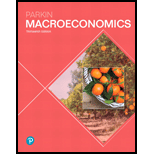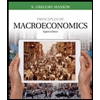
Macroeconomics
13th Edition
ISBN: 9780134744452
Author: PARKIN, Michael
Publisher: Pearson,
expand_more
expand_more
format_list_bulleted
Question
Chapter 9, Problem 26APA
(a)
To determine
Identify Country D’s exchange rate policy and explain the reason of expectation of possible break in the link of the crown and euro might put the crown under pressure.
(b)
To determine
Explain the action in which the central bank of Country D will avoid a break in the link between the crown and the euro.
Expert Solution & Answer
Want to see the full answer?
Check out a sample textbook solution
Students have asked these similar questions
2. Question
The 'Democratic Family' consists of three members {mother m, father f, daughter
d}, that have different preferences with respect to how much money X € [0,8]
they think should be invested in the new family car. These preferences can be
represented by the following utility functions:
-
Mother m: um(X) = 2X - X²
Father f: uf(X) = 10X - X²
- Daughter d: ud(X) = 4X - X²
Calculate for each family member (f, m, d) the preferred amount of money
to invest in the new car denoted by X; for i = {m, f,d}. Assume that
(Xf, Xm, Xd) are the three alternatives on which the family must decide. Show
that each family member has rational preferences over this domain.
Preferences on the family level are determined by pairwise majority voting (all
family members vote on two alternatives). Derive the family preference and
check whether it is rational.
Assume that the final family decision is made by conducting sequential pair-
wise majority voting, where the loosing alternative is eliminated. Does…
3. Question
You invented a new lateral-flow test for asymptomatic Covid-19 detection,
where saliva is entered into a test-tube and then the result is shown directly
on the device. However, to save on costly chemicals you designed the tests
such that it always reports a negative test result. Assume that the incidence
rate is 5 per 1000 and that your test is used for detection of asymptomatic
cases (without symptoms).
(a) Calculate the probability that 100 randomly determined volunteers receive
a correct test result by using the AND-rule and the OR-rule. Can your
test be qualified as a diagnostic test?
(b) The health authorities are investigating the performance of your test.
Government guidelines require a specificity (conditional probability to re-
ceive a negative test result given that the test-taker is not infected with
COVID19) of at least 97% and a sensitivity (conditional probability to
receive a positive test result given that the test-taker is infected with
COVID-19) of at…
3. Question
You invented a new lateral-flow test for asymptomatic Covid-19 detection,
where saliva is entered into a test-tube and then the result is shown directly
on the device. However, to save on costly chemicals you designed the tests
such that it always reports a negative test result. Assume that the incidence
rate is 5 per 1000 and that your test is used for detection of asymptomatic
cases (without symptoms).
(a) Calculate the probability that 100 randomly determined volunteers receive
a correct test result by using the AND-rule and the OR-rule. Can your
test be qualified as a diagnostic test?
(b) The health authorities are investigating the performance of your test.
Government guidelines require a specificity (conditional probability to re-
ceive a negative test result given that the test-taker is not infected with
COVID19) of at least 97% and a sensitivity (conditional probability to
receive a positive test result given that the test-taker is infected with
COVID-19) of at…
Chapter 9 Solutions
Macroeconomics
Ch. 9.1 - Prob. 1RQCh. 9.1 - Prob. 2RQCh. 9.1 - Prob. 3RQCh. 9.1 - Prob. 4RQCh. 9.1 - Prob. 5RQCh. 9.1 - Prob. 6RQCh. 9.1 - Prob. 7RQCh. 9.2 - Prob. 1RQCh. 9.2 - Prob. 2RQCh. 9.2 - Prob. 3RQ
Ch. 9.2 - Prob. 4RQCh. 9.2 - Prob. 5RQCh. 9.2 - Prob. 6RQCh. 9.3 - Prob. 1RQCh. 9.3 - Prob. 2RQCh. 9.3 - Prob. 3RQCh. 9.3 - Prob. 4RQCh. 9.4 - Prob. 1RQCh. 9.4 - Prob. 2RQCh. 9.4 - Prob. 3RQCh. 9 - Prob. 1SPACh. 9 - Prob. 2SPACh. 9 - Prob. 3SPACh. 9 - Prob. 4SPACh. 9 - Prob. 5SPACh. 9 - Prob. 6SPACh. 9 - Prob. 7SPACh. 9 - Prob. 8SPACh. 9 - Prob. 9SPACh. 9 - Prob. 10SPACh. 9 - Prob. 11APACh. 9 - Prob. 12APACh. 9 - Prob. 13APACh. 9 - Prob. 14APACh. 9 - Prob. 15APACh. 9 - Prob. 16APACh. 9 - Prob. 17APACh. 9 - Prob. 18APACh. 9 - Prob. 19APACh. 9 - Prob. 20APACh. 9 - Prob. 21APACh. 9 - Prob. 22APACh. 9 - Prob. 23APACh. 9 - Prob. 24APACh. 9 - Prob. 25APACh. 9 - Prob. 26APACh. 9 - Prob. 27APACh. 9 - Prob. 28APACh. 9 - Prob. 29APA
Knowledge Booster
Similar questions
- I need expert handwritten solutionsarrow_forwardmachine A operated manually cost 2000naira has a life of 2 years, while an automatic machine B cost 5000naira but has a life of 4 years,operating cost for machine A is 4000naira per year while of machine B is 3000naira only, which should be purchased?consider 10% interest I need expert handwritten solutionsarrow_forwardDon't used Ai solutionarrow_forward
- not use ai pleasearrow_forwardUse the following table to work Problems 5 to 9. Minnie's Mineral Springs, a single-price monopoly, faces the market demand schedule: Price Quantity demanded (dollars per bottle) 10 8 (bottles per hour) 0 1 6 2 4 3 2 4 0 5 5. a. Calculate Minnie's total revenue schedule. b. Calculate its marginal revenue schedule. 6. a. Draw a graph of the market demand curve and Minnie's marginal revenue curve. b. Why is Minnie's marginal revenue less than the price? 7. a. At what price is Minnie's total revenue maxi- mized? b. Over what range of prices is the demand for water from Minnie's Mineral Springs elastic? 8. Why will Minnie not produce a quantity at which the market demand for water is inelastic?arrow_forwardDon't give AI generated solution otherwise I will give you downward Give correct answer with explanationarrow_forward
arrow_back_ios
SEE MORE QUESTIONS
arrow_forward_ios
Recommended textbooks for you
 Principles of Economics 2eEconomicsISBN:9781947172364Author:Steven A. Greenlaw; David ShapiroPublisher:OpenStax
Principles of Economics 2eEconomicsISBN:9781947172364Author:Steven A. Greenlaw; David ShapiroPublisher:OpenStax Principles of Economics (MindTap Course List)EconomicsISBN:9781305585126Author:N. Gregory MankiwPublisher:Cengage Learning
Principles of Economics (MindTap Course List)EconomicsISBN:9781305585126Author:N. Gregory MankiwPublisher:Cengage Learning Principles of Macroeconomics (MindTap Course List)EconomicsISBN:9781285165912Author:N. Gregory MankiwPublisher:Cengage Learning
Principles of Macroeconomics (MindTap Course List)EconomicsISBN:9781285165912Author:N. Gregory MankiwPublisher:Cengage Learning Brief Principles of Macroeconomics (MindTap Cours...EconomicsISBN:9781337091985Author:N. Gregory MankiwPublisher:Cengage Learning
Brief Principles of Macroeconomics (MindTap Cours...EconomicsISBN:9781337091985Author:N. Gregory MankiwPublisher:Cengage Learning Principles of Economics, 7th Edition (MindTap Cou...EconomicsISBN:9781285165875Author:N. Gregory MankiwPublisher:Cengage Learning
Principles of Economics, 7th Edition (MindTap Cou...EconomicsISBN:9781285165875Author:N. Gregory MankiwPublisher:Cengage Learning Principles of Macroeconomics (MindTap Course List)EconomicsISBN:9781305971509Author:N. Gregory MankiwPublisher:Cengage Learning
Principles of Macroeconomics (MindTap Course List)EconomicsISBN:9781305971509Author:N. Gregory MankiwPublisher:Cengage Learning

Principles of Economics 2e
Economics
ISBN:9781947172364
Author:Steven A. Greenlaw; David Shapiro
Publisher:OpenStax

Principles of Economics (MindTap Course List)
Economics
ISBN:9781305585126
Author:N. Gregory Mankiw
Publisher:Cengage Learning

Principles of Macroeconomics (MindTap Course List)
Economics
ISBN:9781285165912
Author:N. Gregory Mankiw
Publisher:Cengage Learning

Brief Principles of Macroeconomics (MindTap Cours...
Economics
ISBN:9781337091985
Author:N. Gregory Mankiw
Publisher:Cengage Learning

Principles of Economics, 7th Edition (MindTap Cou...
Economics
ISBN:9781285165875
Author:N. Gregory Mankiw
Publisher:Cengage Learning

Principles of Macroeconomics (MindTap Course List)
Economics
ISBN:9781305971509
Author:N. Gregory Mankiw
Publisher:Cengage Learning